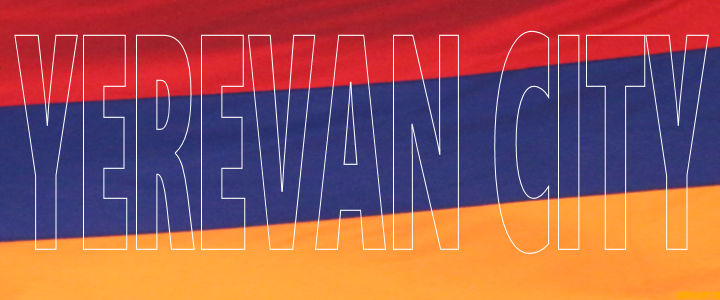Advertisement
Tsitsernakaberd Armenian Genocide Memorial Complex
Come visit one of Armenia’s top historical sites located in Yerevan and learn about the history of the Armenian Genocide.
Published: April 22, 2023
The Armenian Genocide Memorial is located in Yerevan, Armenia, which is also known as the Tsitsernakaberd Memorial Complex. Tsitsernakaberd which translates to (Swallow’s Fortress). The complex was built to commemorate the victims of the Armenian Genocide that started in the Ottoman Empire on April 24, 1915, and lasted till 1923.
Background
Shortly after the Turks entered World War I, the current government of the Ottoman Empire which was known as the “Young Turks” formulated their plan to use the war and rid the Ottoman Empire of non-Turks and most notably the Christian non-Turks which majority were the Armenians.
During this time period, more than 1.5 million Armenians were killed and many more forcibly deported from their homes and lands within the Ottoman Empire.
Design of the complex and museum
The Armenian Genocide Memorial Complex occupies up to 4500 square meters on top of a hill which in the past was the former ruins of the Tsitsernakaberd Fortress. Some remnants of the fortress can still be seen on some parts of the grounds.
The architects of the initial memorial complex Artur Tarkhanyan, Sashur Qalashyan, and Sculptor Ferdinand Araqelyan designed the complex.
The architects of the Museum are Sashur Qalashyan, Lyudmila Mkrtchyan, Arthur Tarxanyan, and Sculptor Ferdinand Araqelyan.
Construction of the Armenian Genocide Memorial complex began in 1965 under the former Soviet Union and completed in 1967. The memorial formal public opening occurred on November 29, 1967.
It was finalized in 1995 with the Armenian Genocide Museum-Institute.
Advertisement
Descriptions of the memorial complex
100 Meter Memorial Wall
The 100-meter basalt memorial wall leads to the eternal flame and the 44-meter-tall granite monument. On the wall are listed the names of more than fifty cities, both small and large. These cities largely populated by ethnic Armenians were the centers of deportation and massacres by the Turkish Ottoman government.
The following towns and cities engraved on the wall (Armenian – English translation):
-
Կոստանդնուպոլիս – Constantinople
-
Քյոթահիա – Kutahya
-
Զմյուռնիա – Smyrna
-
Նիկոմեդիա – Nicomedia
-
Բրուսա – Bursa
-
Փանդերմա -Panderma
-
Անգորա – Ankara
-
Յոզղատ – Yozgat
-
Կեսարիա – Caesarea
-
Տրապիզոն – Trabzon
-
Սամսուն – Samsun
-
Օրդու – Ordu or Altınordu
-
Սեբաստիա – Sebastea
-
Թոքաթ – Evdokia (Tokhat, Tokat)
-
Ամասիա -Amasia
-
Գյուրուն – Ghazl-Gyrun
-
Գարահիսար – Karahisar
-
Զեյթուն – Zeitun, Zeytun
-
Սիս – Sis
-
Ադանա – Adana
-
Մարաշ – Marash
-
Հաճըն – Hachn
-
Այնթապ -Aintap
-
Ուրֆա – Urfa
-
Բիրեջիկ – Birecik
-
Մուսա Լեռ – Musa Dagh, Mount Musa
-
Խարբերդ – Kharberd
-
Արաբկիր – Arabkir
-
Չարսանջակ – Charsanjak
-
Մալաթիա – Malatya
-
Աղին- Aghin
-
Էրզրում – Erzurum
-
Երզնկա – Erzincan
-
Խնուս – Hinis
-
Բաբերդ – Bayburt
-
Կամախ – Kemah, known historically as Ani-Kamakh, Gamakh, Kamacha or Kamachon is a town in
Erzincan Province in the Eastern Anatolia Region of Turkey.
-
Դերջան – Tercan is a town and seat of Tercan District of Erzincan Province in the
Eastern Anatolia region of Turkey.
-
Բայազետ – Bayazet
-
Սասուն – Sasun
-
Բիթլիս – Bitlis
-
Մուշ – Mush
-
Խիզան – Hizan is a town in Bitlis Province, Turkey.
-
Սղերդ – Siirt is a city in the Siirt District of Siirt Province in Turkey
-
Դիարբեքիր – Diyarbakır is the largest Kurdish-majority city in Turkey.
-
Բալու – Palu
-
Արղանա – Maden
-
Վան – Van
-
Մանազկերտ – Malazgirt
-
Բաշկալե – Bashkale
-
Շատախ – Shatakh
-
Դեյր Էզ Զոր – Deir ez-Zor is the largest city in eastern Syria and the seventh largest
in the country.
-
Ադաբազար – Atabazar or Adabazar
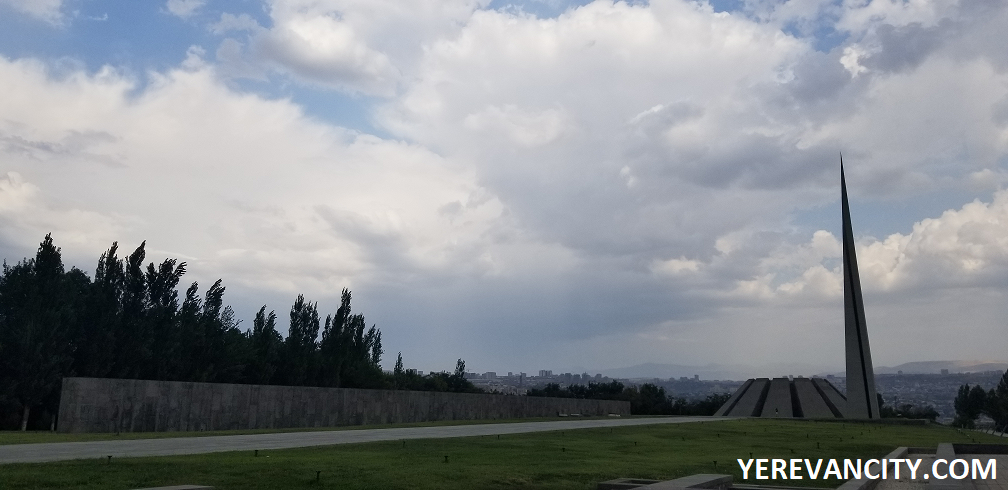
12 Slabs (Basalt)
The circle of 12 basalt slabs that liken the Armenian khachkars incircle the eternal flame that represents the 1.5 million Armenians who lost their lives during the genocide of 1915. On April 24 of each year Armenians and foreigners whom participate, walk to eternal flame to pay their respects. During this day many flowers and roses are placed around the flame.
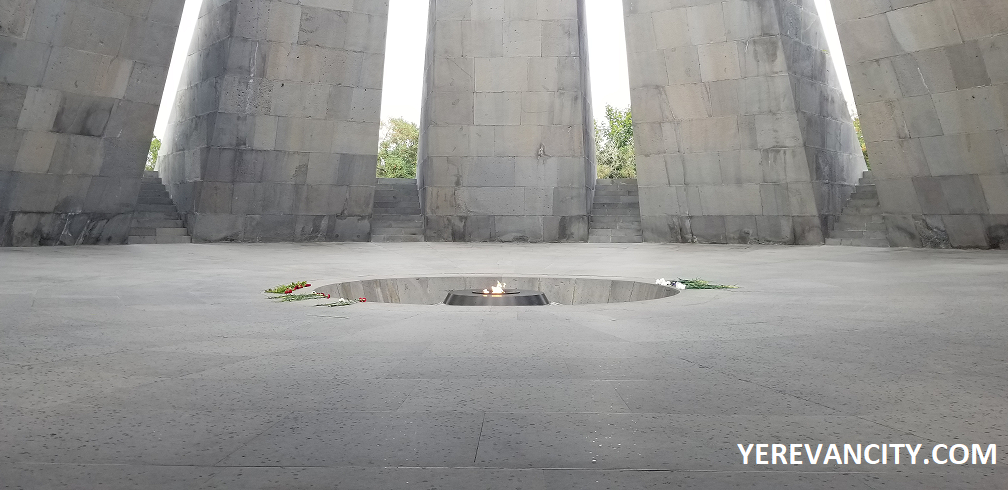
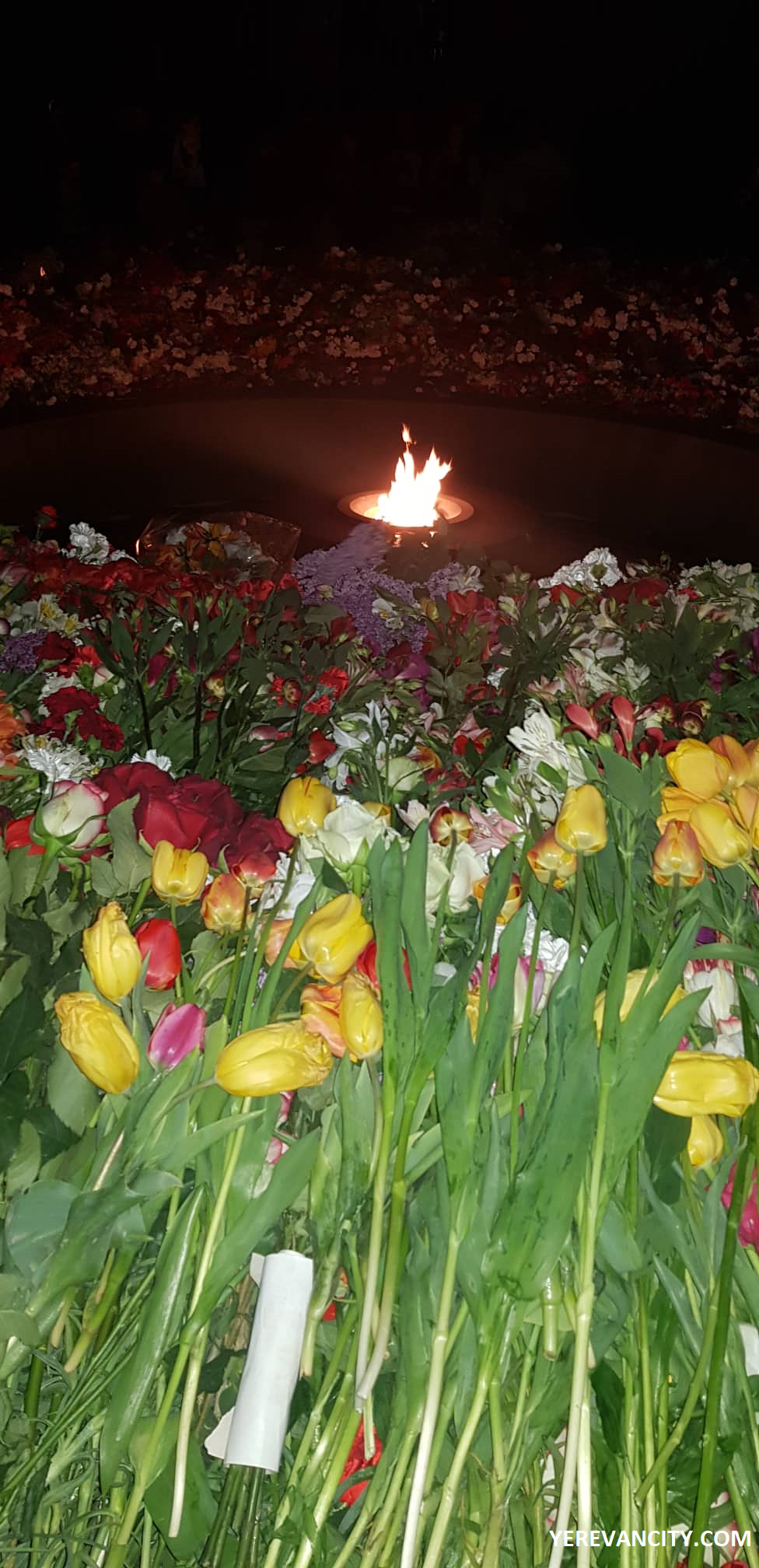
44 Meter granite monument
Next to the monument of basalt slabs and the eternal flame is the 44-meter split granite monument. This monument reaches to the skies and overlooks the city of Yerevan. When looking at it you will see that the monument is split in the middle.

Armenian Genocide Museum-Institute
Opened in 1995. This part of the complex is the museum which is located under the complex.

Memory Alley (Fir Alley)
This area is a special park of fir trees, first established in 1997. The fir tree is known to be the tree of eternity, determination, and perseverance. A symbol of the Armenian spirit and history. The trees also memorialize those of the genocide.
The first fir tree of Memorial Alley was planted in 1997 by United States Senator Robert Dole to honor the memory of Hampar Kelikian. Hampar Kelikian was an Armenian-American orthopedic surgeon who was a survivor of the Armenian Genocide for the village of Hajin in Western Armenia during the Ottoman Empire.
International recognition of the Armenian Genocide
As of the beginning of 2023, the countries listed below have recognized the Armenian Genocide of 1915.
-
Argentina
-
Armenia
-
Austria
-
Belgium
-
Bolivia
-
Brazil
-
Canada
-
Chile
-
Cyprus
-
Czech Republic
-
France
-
Germany
-
Greece
-
Italy
-
Latvia
-
Lebanon
-
Lithuania
-
Luxembourg
-
Mexico
-
Netherlands
-
Paraguay
-
Poland
-
Portugal
-
Russia
-
Scotland
-
Slovakia
-
Sweden
-
Switzerland
-
Syria
-
United States
-
Uruguay
-
Vatican City
-
Venezuela
-
Wales

With continued international recognition and continued future recognition of countries, the Armenian Genocide will be remembered and help memorialize those who perished and the families affected. As well as remember those who fought to assist and aid the evacuation of Armenians.
Because of inaction and denial of the Armenia Genocide of 1915, it became a catalyst for Adolf Hitler’s invasion of Poland many years later in 1 September 1939. Below is the speech given by Adolf Hitler to the Wehrmacht commanders prior to the invasion of Poland and referencing the Armenian Genocide. This was the English translation by Louis P. Lochner who wrote the book “What About Germany,” published in 1942. During the Nuremberg Trials, the speech was also known as the L-3 document.
Obersalzberg Speech
Our strength consists in our speed and in our brutality. Genghis Khan led millions of women and children to slaughter – with premeditation and a happy heart. History sees in him solely the founder of a state. It’s a matter of indifference to me what a weak western European civilization will say about me. I have issued the command – and I’ll have anybody who utters but one word of criticism executed by a firing squad – that our war aim does not consist in reaching certain lines, but in the physical destruction of the enemy. Accordingly, I have placed my death-head formation in readiness – for the present only in the East – with orders to them to send to death mercilessly and without compassion, men, women, and children of Polish derivation and language. Only thus shall we gain the living space (Lebensraum) which we need. Who, after all, speaks today of the annihilation of the Armenians?
Adolf Hitler
22 August 1939
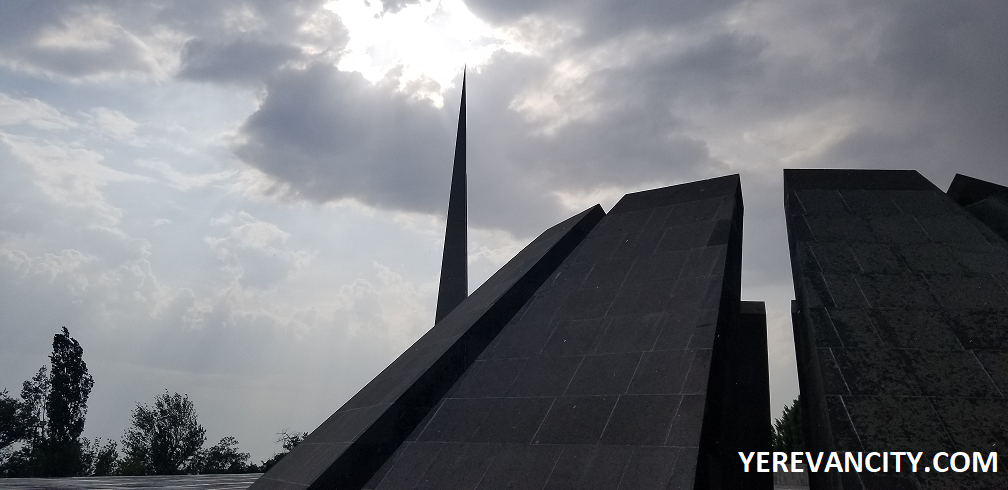
Planning your visit
The Armenian Genocide Memorial Complex is one of many historical attractions and a must to put on your list when traveling to Yerevan.
There are many tour agencies that can help with a guided tour or travel on your own using the many modes of transportation to the complex.
Visit the official Armenian Genocide Memorial website: genocide-museum.am

Advertisement
